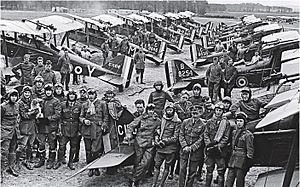Clairmarais aerodrome facts for kids
Quick facts for kids
Clairmarais aerodrome
|
|
|---|---|

Officers of No 1 Squadron, RAF with SE5a biplanes at Clairmarais aerodrome, July 1918. Picture taken by 2nd Lt D McLellan.
|
|
| Summary | |
| Airport type | Military airfield |
| Location | Clairmarais, Pas-de-Calais, France |
| In use | First World War |
| Occupants | Royal Flying Corps/ Royal Air Force |
| Coordinates | 50°46′20″N 02°19′30″E / 50.77222°N 2.32500°E |
Clairmarais aerodrome was an important airfield in France. It was used by British air forces during the First World War. This airfield is also called Clairmarais North. It is near the towns of St. Omer and Ypres. Later, during the Second World War, German forces briefly used the airfield.
Contents
Clairmarais Aerodrome in World War I
Clairmarais aerodrome was a busy airfield during the First World War. It was home to many squadrons from the Royal Flying Corps (RFC). The RFC was the air force of the British Army. Later, it became the Royal Air Force (RAF).
Many different air squadrons were based here. These included RAF Squadrons 1, 20, 27, 49, 54, 58, 65, 74, and 98. Also, No. 9 Squadron of the Royal Naval Air Service (which later became RAF Squadron 209) was here. Even No. 4 Squadron of the Australian Flying Corps used this airfield.
Brave Pilots and Famous Flights
A very brave pilot named Thomas Mottershead took off from Clairmarais. This was on January 7, 1917. He was flying a Royal Aircraft Factory F.E.2d plane. During this flight, he earned the Victoria Cross. This is the highest award for bravery in the British military. Sadly, he died from his injuries.
Another famous pilot, Harry Cobby, was also based at Clairmarais. He was a "fighter ace," meaning he shot down many enemy planes. He achieved almost half of his victories while flying from this aerodrome. Harry Cobby later became a high-ranking officer in the air force.
A Squadron Tradition
There is a famous photograph taken at Clairmarais in July 1918. It shows pilots from No. 1 Squadron RAF with their Royal Aircraft Factory S.E.5a Scout planes. The planes are lined up tail-to-tail. This picture was taken by 2nd Lt David McLellan.
This photograph started a special tradition for No. 1 Squadron. They have continued to take squadron photos in the same way for many years. The original photo is now kept at the Imperial War Museum.
Clairmarais Aerodrome in World War II
During the Second World War, the airfield was used again. The German air force, called the Luftwaffe, rebuilt it. It became a smaller, supporting airfield for their main base nearby.
The airfield at Clairmarais did not have a hard, paved runway. This meant it could not be used when the ground was wet. A small building, like a shed, was built from metal sheets. It was cleverly disguised to look like a church.
On the south side of the airfield, there was a special area. It had more than thirty protected spots for aircraft. These spots, called "revetments," helped keep the planes safe. The German fighter group Jagdgeschwader 26 used the airfield in 1940 and 1941. However, by 1942, it was no longer in use.
By March 1944, Allied planes took photos of the airfield. These photos showed that the runway had been blocked. Trenches and holes from mines made it impossible to use.

